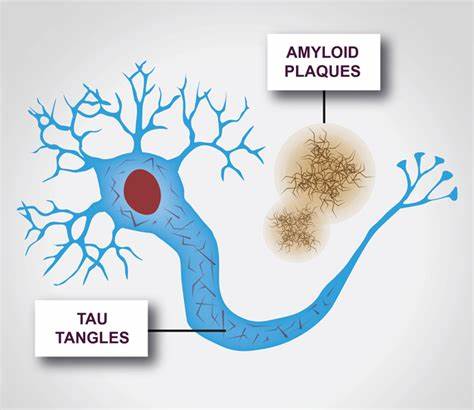Amyloid and Tau in Alzheimer’s
Exposing the Enigma: Alzheimer’s Disease and Tau Protein in Relation to the Amyloid Hypothesis
Alzheimer’s disease (AD) is a neurological condition that worsens with time and impairs a person’s memory and cognitive function. Researchers are hard at work figuring out the intricate mechanics underlying this illness. There are now two main participants: tau tangles and amyloid plaques. The amyloid hypothesis and tau protein’s function in the pathophysiology of Alzheimer’s disease are covered in detail in this blog post.
Table of Contents

The Amyloid Hypothesis: A Complicated Case
Amyloid and Tau in Alzheimer’s
Amyloid hypothesis is one of the most well-known ideas on Alzheimer’s disease. It suggests that one of the main factors setting off the illness cascade is the aberrant build-up of a protein fragment known as beta-amyloid.
This is an explanation of the theory:
Amyloid and Tau in Alzheimer’s
- amyloid precursor protein: The protein known as amyloid precursor protein (APP) is found normally in the brain. It is divided into smaller pieces by a number of biological processes, one of which being beta-amyloid.
- Amyloid Plaques: In the brain, sticky plaques are created between nerve cells when beta-amyloid clumps together excessively.
Amyloid and Tau in Alzheimer’s
According to the amyloid hypothesis, these plaques obstruct nerve cell-to-nerve cell transmission, setting off a series of events that include:
- Inflammation: The brain has an inflammatory reaction when plaques are present, which further damages brain tissue.
- Tau Tangles: Tau is another protein that often aids in maintaining the structural integrity of nerve cells. Tau deviates from normal and tangles into fibres in Alzheimer’s disease.
- Neurodegeneration: The hallmark signs of Alzheimer’s disease are brought on by the loss of nerve cells and shrinkage of brain tissue as a result of the interaction of plaques, inflammation, and tau tangles.
Amyloid and Tau in Alzheimer’s
The amyloid hypothesis is not without detractors, though. According to some study, amyloid plaques could not be the main cause of the disease, but rather a byproduct of the underlying process.
Beyond Amyloid: Tau Protein’s Captivating Function
Amyloid and Tau in Alzheimer’s
Tau protein is essential for preserving the integrity and structural integrity of nerve cells. When tau has Alzheimer’s disease, it changes:
- Normal Tau: Sturdy tau gives nerve cells stability and structure by functioning as a scaffold.
- Abnormal Tau: When tau is affected by Alzheimer’s disease, it gets hyperphosphorylated, which means it picks up more phosphate groups. The aberrant tau loses its ability to function and creates neurofibrillary tangles, which are knotted fibres inside nerve cells.
The internal transport mechanism of nerve cells is interfered with by these tangles, impairing their functionality and ultimately resulting in cell death.
The Puzzle’s Complexities: Amyloid, Tau, and Other Things
Amyloid and Tau in Alzheimer’s
Research on the connection between tau and amyloid is still ongoing. Among the options are:
- Amyloid causing tau pathology: According to the amyloid hypothesis, tau hyperphosphorylation and tangle formation may be brought on by amyloid buildup.
- Independent but concurrent processes: There may be a common underlying cause for both tau and amyloid abnormalities, and both lead to neurodegeneration.
- Tau taking centre stage: According to some research, tau disease may trigger the neurodegenerative cascade even before amyloid accumulation.
In the Path to a More Complete Knowledge
Although tau protein dysfunction and the amyloid hypothesis are important factors, they probably aren’t the only ones at fault. It’s probable that additional elements including inflammation, genetic susceptibility, and environmental variables contribute to the intricate pathophysiology of Alzheimer’s disease.
It is essential to comprehend these systems in order to create treatments that work. Scholars are investigating a range of approaches, such as:
- Targeting amyloid deposition: Research is being done to create medications that either stop the forming of amyloid plaques or encourage their removal from the brain.
- Inhibiting tau hyperphosphorylation: Treatments targeted at stopping aberrant tau protein alterations have the potential to delay or stop neurodegeneration.
- Multiple target strategies: Treatment approaches that combine tactics targeting anomalies of both tau and amyloid, as well as other contributory variables, may be more thorough.
In summary: A Bite from the Jigsaw
Amyloid and Tau in Alzheimer’s
Important information about the pathophysiology of Alzheimer’s disease is provided by the tau protein dysfunction theory and the amyloid hypothesis. Even though their precise functions and interactions are still being worked out, knowing these systems helps to create new treatment approaches. We can aspire for a time in the future when we can successfully fight this terrible disease as knowledge advances.


